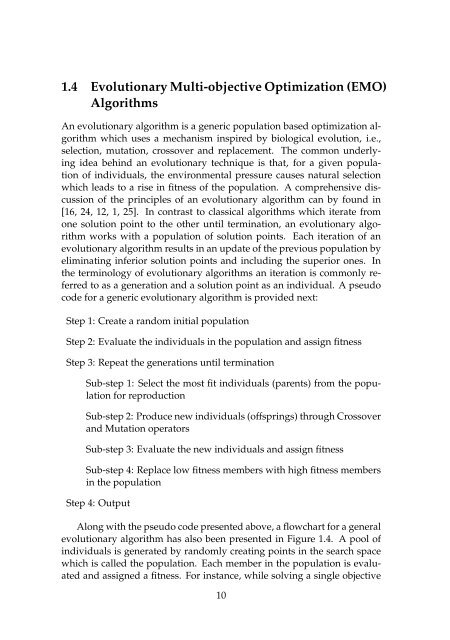Progressively Interactive Evolutionary Multi-Objective Optimization ...
Progressively Interactive Evolutionary Multi-Objective Optimization ...
Progressively Interactive Evolutionary Multi-Objective Optimization ...
Create successful ePaper yourself
Turn your PDF publications into a flip-book with our unique Google optimized e-Paper software.
1.4 <strong>Evolutionary</strong> <strong>Multi</strong>-objective <strong>Optimization</strong> (EMO)<br />
Algorithms<br />
An evolutionary algorithm is a generic population based optimization algorithm<br />
which uses a mechanism inspired by biological evolution, i.e.,<br />
selection, mutation, crossover and replacement. The common underlying<br />
idea behind an evolutionary technique is that, for a given population<br />
of individuals, the environmental pressure causes natural selection<br />
which leads to a rise in fitness of the population. A comprehensive discussion<br />
of the principles of an evolutionary algorithm can by found in<br />
[16, 24, 12, 1, 25]. In contrast to classical algorithms which iterate from<br />
one solution point to the other until termination, an evolutionary algorithm<br />
works with a population of solution points. Each iteration of an<br />
evolutionary algorithm results in an update of the previous population by<br />
eliminating inferior solution points and including the superior ones. In<br />
the terminology of evolutionary algorithms an iteration is commonly referred<br />
to as a generation and a solution point as an individual. A pseudo<br />
code for a generic evolutionary algorithm is provided next:<br />
Step 1: Create a random initial population<br />
Step 2: Evaluate the individuals in the population and assign fitness<br />
Step 3: Repeat the generations until termination<br />
Sub-step 1: Select the most fit individuals (parents) from the population<br />
for reproduction<br />
Sub-step 2: Produce new individuals (offsprings) through Crossover<br />
and Mutation operators<br />
Sub-step 3: Evaluate the new individuals and assign fitness<br />
Sub-step 4: Replace low fitness members with high fitness members<br />
in the population<br />
Step 4: Output<br />
Along with the pseudo code presented above, a flowchart for a general<br />
evolutionary algorithm has also been presented in Figure 1.4. A pool of<br />
individuals is generated by randomly creating points in the search space<br />
which is called the population. Each member in the population is evaluated<br />
and assigned a fitness. For instance, while solving a single objective<br />
10
















